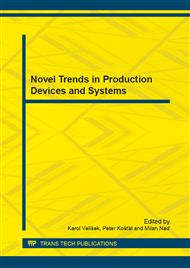[1]
K. Weinert., D. Biermann, Spanende Fertigung. Vulkan Verlag, Essen, 2008. pp.29-55., 168-187.
Google Scholar
[2]
N. Taniguchi, Current status in, and future trends of ultraprecision machining and ultrafine materials processing. Annals of the CIRP, Vol. 32/2 (1983) pp.573-582.
DOI: 10.1016/s0007-8506(07)60185-1
Google Scholar
[3]
G. M. Maitra, Handbook of gear design. McGraw Hill, New Delhi, 2010, pp.18-24.
Google Scholar
[4]
T. Bausch et al, Innovative Zahnradfertigung. Expert Verlag, Renningen, 2011, pp.1-4., 366-389.
Google Scholar
[5]
S. P. Radzevich, Dudley's handbook of practical gear design and manufacture. CRC Press, Boca Raton, 2012. pp.371-417.
Google Scholar
[6]
H. K. Tönshoff, C. Arendt, R. Ben Amor, Cutting of hardened steel. Annals of the CIRP, Vol. 49/2 (2000) pp.547-566.
DOI: 10.1016/s0007-8506(07)63455-6
Google Scholar
[7]
G. Ackerschott, Grundlagen der Zerspanung einsatzgehärteter Stähle mit geometrisch bestimmter Schneide. Dissertation RWTH, Aachen (1989).
DOI: 10.1007/978-3-662-07204-2_3
Google Scholar
[8]
G. Varga, Effects of Technological Parameters on the Surface Texture of Burnished Surfaces, Key Engineering Materials, Vol. 581 (2014) Precision Machining VII, pp.403-408. ISSN 1013-9826.
DOI: 10.4028/www.scientific.net/kem.581.403
Google Scholar
[9]
K. -F. Koch, Technolgie des Hochpräzisions-Hartdrehens. Dissertation RWTH Aachen. Shaker Verlag, Aachen, 1996, Band 5/96.
Google Scholar
[10]
S. Jochmann, Untersuchungen zur Prozess- und Werkzeugauslegung beim Hochpräzisionshartdrehen. Dissertation RWTH Aachen, Shaker Verlag, Aachen, 2001, Band 19/(2001).
Google Scholar
[11]
J. P. Davim et al., Surface integrity in machining. Springer Verlag, London, (2010).
Google Scholar
[12]
E. Brinksmeier, Prozeß- und Werkstückqualität in der Feinbearbeitung. Habilitation Universität Hannover. VDI Verlag, Düsseldorf, pp.51-56. (1991).
Google Scholar
[13]
W. König, R. Komanduri, H. K. Tönshoff, G. Ackerschott, Machining of hard materials. CIRP Annals Vol. 33/2 (1984) pp.417-427.
DOI: 10.1016/s0007-8506(16)30164-0
Google Scholar
[14]
Y. Ohbuchi, T. Obikawa, Finite element modeling of formation in the domain of negative rake angle cutting. Transactions of the ASME, Vol. 125/July (2003) pp.324-332.
DOI: 10.1115/1.1590999
Google Scholar
[15]
M. E. Merchant, Mechanics of the metal cutting process. I. Orthogonal cutting and a type 2 chip. Journal of Applied Physics, Vol. 16/5 (1945) pp.267-275.
DOI: 10.1063/1.1707586
Google Scholar
[16]
E. H. Lee, B. W. Shaffer, The theory of plasticity applied to a problem of machining. Transactions of the ASME, Vol. 18. (1951) pp.405-413.
Google Scholar
[17]
A. L. Vorontsov, N. M. Sultan-zade, A. Yu. Albagachiev, Development of a new theory of cutting: 2. A Review of Cutting Theory. Russian Engineering Research, Vol. 28/2. (2008) pp.144-155.
DOI: 10.3103/s1068798x0804014x
Google Scholar
[18]
P. L. B. Oxley, The mechanics of machining: an analytical approach to assessing machinability, Ellis Horwood Limited, Chicester, UK, (1989).
Google Scholar
[19]
N. N. Zorev, Metal cutting mechanics. Pergamon Press, (1966).
Google Scholar
[20]
N. Fang, tool-chip friction in machining with a large negative rake angle tool. Wear, Vol. 258. (2005) pp.890-897.
DOI: 10.1016/j.wear.2004.09.047
Google Scholar
[21]
D. A. Stephenson, J. S. Agapiou, Metal cutting theory and practice. CRC Press, Boca Raton US, (2005).
Google Scholar
[22]
J. Beňo, Theory of metal cutting (in Slovakian). Vienala Košice, (1999).
Google Scholar
[23]
T. Atkins, The Science and engineering of cutting. Butterworth-Heinemann&Elsevier, (2009).
Google Scholar
[24]
O. Bílek, I. Lukovics, Determination of the Residual Stress Through the Thickness of Plastic and Metalic.
Google Scholar
[25]
Parts. Manufacturing Technology. 2006, Vol. VI., pp.12-16, ISSN 1213248-9.
Google Scholar
[26]
Z. Palmai, Machinability of metals (in Hungarian). Műszaki Könyvkiadó, Budapest, (1983).
Google Scholar
[27]
B. Mikó, J. Beňo, I. Maňkova, Experimental verification of cusp heights when 3D milling rounded surfaces, Acata Politechnica Hungarica, Vol 9/6 (2012) pp.101-116.
DOI: 10.12700/aph.9.6.2012.6.7
Google Scholar
[28]
S. Aykut, A. Kentli, S. Gülmez, O. Yazicioglu, Robust multiobjective optimization of cutting parameters in face milling, Acata Politechnica Hungarica, Vol 9/4 (2012) pp.85-100.
Google Scholar
[29]
J. Kundrak, The scientific principles of increasing the effectiveness of inner surfaces' cutting with CBN tools. Academic Doctoral Dissertation. Kharkov, 1996 p.368. (In Russian).
Google Scholar
[30]
V. P. Astakhov, Metal cutting mechanics, CRC Press, Boca Raton, (1999).
Google Scholar
[31]
M. C. Shaw, Metal cutting principles. Oxford University Press, New York, 2005. pp.472-478.
Google Scholar
[32]
Third Wave AdvantEdgeTM User's Manual, Version 5. 9.
Google Scholar
[33]
I. Al-Zkeri, Finite Element Modeling of Hard Turning. VDM Verlag Dr. Müller. Saarbrücken, (2008).
Google Scholar
[34]
CSN 41 4220/ISO 683/11-73.
Google Scholar
[35]
O. C. Zienkiewicz, R. L. Taylor, The finite element method. For solid and structural mechanics. Butterworth-Heinemann&Elsevier, (2005).
Google Scholar
[36]
A. G. Mamalis, J. Kundrak, K. Gyani, On the dry machining of steel surfaces using superhard tools. International Journal of Advanced Manufacturing Technology. Vol. 19. (2002) pp.157-162.
DOI: 10.1007/s001700200009
Google Scholar
[37]
G. Szabo, J Kundrak, Investigation on coherences between residual stresses and tool geometry by hard turning. Hungarian Journal of Industrial Chemistry. Vol. 39/2 (2011) pp.289-294.
Google Scholar


